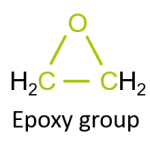We offer the following tests for epoxy resins:
shrinkage behaviour | cross-linking analysis, reaction kinetics | expansion coefficients | rheology | mechanical testing | dynamic testing | mixing behaviour | demoulding behaviour | hardness | creep | compression set
Cured epoxy resins (EP) are thermosetting plastics, which are mainly used as adhesives, casting resins and as matrix material in fiber-reinforced plastics for lightweight construction. Due to their three-dimensional cross-linking, they have good mechanical properties and excellent resistance to temperature influences and chemicals.
Epoxy resins are based on the presence of a epoxy groups within the molecular chain of at least one starting component:

Epoxy resins are usually available in several starting components or premixed resin/hardener systems. In addition to the epoxy resin, amine-containing hardeners are used, which enable three-dimensional cross-linking via the epoxy groups. In addition to liquid processing, epoxy resins are used as pre-crosslinked compounds in injection molding (free-flowing thermosets) or in compression molding (e.g. SMC).
The cross-linking reaction is a polyaddition, no further decomposition products are released. In order to achieve the desired properties, it is therefore important to ensure the exact ratio of resin and hardener and good mixing. Additives such as catalysts, inhibitors or release agents also increase the complexity of the process.

The boundary conditions of the curing process play a major role in the chemical reaction. Depending on the selected temperatures or pressures, different mechanisms (reaction with primary amines -> chain growth; reaction with secondary amines -> branching) take place preferentially, resulting in corresponding properties of the epoxy.

